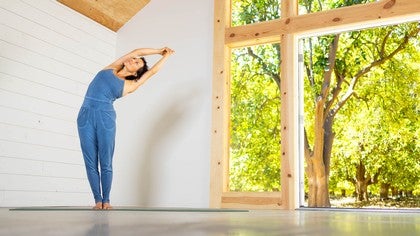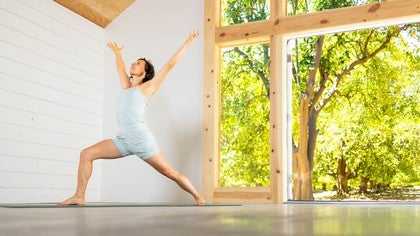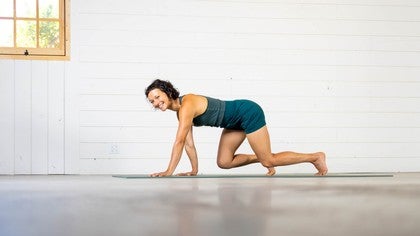Description
Please Note: This class includes a series in which a Tennis Ball is used as a tool to connect to the pelvic floor. Due to the nature of the exercise, you may need to use a ball that is softer in texture, omit the use of a ball completely, or skip the sequence altogether.
About This Video
Transcript
Read Full Transcript
Hi, friends. Warm welcome back to our 1st session of the 4 deep core. We'll be able to, in the next two classes, take a look at the 4 musculature that make up our intrinsic core. Today's class will focus more on the pelvic diaphragm or the pelvic floor and the transversus abdominis, which are those deeper abdominal muscles And mostly today, we'll work with them at the region of our lower belly. So in between our two frontal hip bones.
We'll begin with some mapping for the pelvic floor. And for that, if you have a ball at home, grab it, you could use tennis ball will work great. That's what I'll show you with today or a specific rolling ball as well. And you can also leave the ball out and use your awareness. The ball simply gives us a little more access to getting that bio feedback. For today, you might also wanna set up on a blanket to elevate your hips, And a couple of blocks are always a nice thing to have for your flow.
So let's begin with our ball. Feel free to elevate your hips, And we'll place our ball right in the region of our pelvic floor. So in between our pubic bone, tailbone, and two sits bones. Again, this is optional. You can leave this part out. So we'll take that and place it right in the diamond of those bony structure and if it feels a little intense right away, you can throw a blanket over top of it to soften the pressure or have your sit bones on a blanket as well. I've done this a lot. I did this a lot pre and post pregnancy, and something else I should mention is that I find this session really useful for postpartum care.
So being on that ball, Notice what you notice. You might feel one side of the diamond of your pelvic floor a little bit tighter. Maybe you feel a little bit more into one side. There's more sensation on one side that could be front to back or left to right. So something I like to do here is to create a little bit of movement. So those sufi circles, small movements.
Sometimes I lean to one side and kinda reach one sit bone out to the side and then the other. So I make a little bit of a broader surface there to the, pelvic floor. And you might roll around something I'm also working with here is calling this my pelvic diaphragm instead of pelvic floor because floor, you know, insinuates that it's a hard flat and movable surface. And this is certainly an area of our bodies that has a lot of resilience, a lot of movement, a lot of play able to contract and release, and that's what we'll be exploring today. So with that movement, anytime you need to take the ball out, Here, can you start to draw the muscles of your pelvic floor a little up and off the ball? And for me, if you have the ball there, I feel like it's a lot easier to land and locate with that feedback. So can you draw the center point of your pelvic diaphragm up and then release it.
Now you can use your breath here on your hail, you can draw up. And on your inhale, you can release into the ball, almost push into the ball with the floor of your pelvis. Exhale drawing up, and inhale breathing into the ball. So let's do this a couple more breaths. You might even close your eyes.
And if you're not feeling much, stick with it. I would even recommend to come back to this a couple of times this week or maybe once a week. Every time you're not noticing, that's an experience of noticing that. And each time you come back, you're strengthening that neural communication, that neuromuscular communication. And that's what somatic is all about. So another breath in and out, you might go back to a little bit of movement, rolling here. So option to take that ball out from underneath you or keep it there, and we can come to focus on this region of our lower belly. So in between the two hip points at the front, on your exhale breath, can you think about squeezing these together.
So I imagine almost a widening of the back of the pelvis and a narrowing of the front. So inhale. And then on your exhale squeezing those 2 frontal hip bones together. You might not get a lot of movement, but you can imagine that's happening. So it says squeezing and perhaps a narrowing of the front of the pelvis and a deepening of the front of the pelvis.
Let's link these 2 together. So your inhale, you can drop into the ball with your pelvic diaphragm. On your exhale, you could draw up and then that little squeeze together of your lower belly. Keep going with it. Inhale open, and exhale your drawing up and squeezing.
Any of you yogis that have been working with moola and Udiana banda, this is the somatic way of working with. Those root lock, flying upward lock, really important here that you go for the release on the inhale. So you don't stay chronically tense or contracted. And in somatics, we notice the opposite. So Are you feeling here that you're a little more proficient at the opening or a little more proficient at the drawing in?
And can you focus on the phase? Put the emphasis on the phase that you're having a little more difficulty with. One more breath. So good. Okay. So if you have that ball there, you can lean to the side, take it out, place it to the side. Let's go back into those souffy rolls. You might make them a little bit bigger now. Yeah.
Noticing any freedom that you have here in the base of your spine. You can lean to one side and push into your opposite arm, get a bit of a side stretch. Keep going with the circles and switch directions. Coming into the center. We'll come onto our hands and our knees.
In tabletop and find a couple of cat cows. Is it possible to feel here when you arch your pelvic floor opens a little. And then when you round under exhaling, feeling the pelvic floor drawing in and up. Inhale opening that region. And as you exhale, you can take that transverse abdominis to gather doming that back towards your low pack, linking that with the breath, the inhale as the expansion, and exhale is the up and in.
One more time. Alright. Come to a neutral tabletop there. Take a breath in. And as you exhale, you can make a sound if you want. Exhaling out of your mouth.
And think about drawing the pelvic floor and that lower abdominal region together and up Now hold it at the bottom of your exhale. So you're just gently bracing there, but keep breathing. Keep a little bit of that bracing and keep breathing. Now with that bracing, can you take your right leg back, your left arm four words, keep a bit of that bracing. And if it works for you, your right leg can float and your left arm can float.
Keep a whisper of that bracing breathe in, and breathe out both limbs can come back down in, he'll find an arch, and exhale find a round. Come to neutral, take a breath in. If you like, make that sound, draw in and up. And then if you like, left leg back and right arm forwards, stay there. Keep a whisper of that bracing if you like, lift.
Float. Take a breath. Try not to backbend in your spine. And then release everything out. Inhale and arch, exhale, and round.
One more time, breathe in. Connect everything in that lower region. And then right leg left arm. Breathe into your lower ribs. Have a fullness of breath with that little bit of bracing and then release it out inhale arch.
Exhale round. Come to neutral, breathe in. Connect in pelvic floor, transverse abdominals, left leg, right arm, Keep a whisper of the brace, but keep breathing fully through your lower ribs, and then release it. Inhale arch, exhale round under. Nice, tuck your toes, come back into your dog, word facing form.
So as you're working with this, the idea is not to get stuck. You know, you can brace a little bit. You can let go of the braze. And use the bracing when you need to. We'll explore that in this flow of practice.
As you're ready walking your feet towards your hands, lengthen out for a word fold. Arms out and wide come all the way up. Hands to heart. You're invited to make an ohm sound with me. Your breath and Exhale it out, inhale from home.
Breathe into your hands. Hands down by your sides. Inhale your arms up. Hacks hail your forward fold. Inhale, long, spine, downward facing dog.
Through angry, cut plank, lengthen it out lower. You can always take your knees down. For cobra or up dog, and downward facing dog. Read in. Read out.
In out. Feet to the top of the mat, however you do. Forward fault. All the way up, and release your arms by your sides. Bend your knees here chair form.
Forward fold. Lengthen your spine, halfway lift. Find your down dog. Roll into that scapular protraction and Greek hat planks straighten it out and lower. Upward dog or cobra, you're a choice.
Downward facing form. Left leg high. Left foot for Warrior 1, back foot on an angle. Inhale find your warrior 1. Come on up.
Exhale shift forwards. Make a long line between fingertips and back right heel. Take a breath in. And as you exhale, pelvic floor and TV a transverse abdominis. And then in, he'll come up with a little bit of that bracing.
Keep it and open up into a big wide wide position look up. Exhale come more upright. Shift a little forwards. Turn your back foot so that you're on tippy toes, and it's going to be a big step forward. So it might be a couple of steps or one big step hands to your hips, right knee in towards your chest.
I'm gonna turn this way so you can see. Take your right knee out to the side. This is a hip car. Roll your inner knee in towards the floor internal rotation. Knees together and then kick your knee behind you without back bending, hip extension, and draw it back up. Stay with me here.
Take a breath in one more, but draw in and up through your lower belly pelvic floor. And to create that same movement, roll in. Needs together. Extend. Draw in. Now you may cut your knee. You might cut your toe and reach your left arm up.
And you might take it out to the side, knee, or toe, play with it for a breath. And then bring your right knee back into your chest. I know. And step it back to your warrior 1. Inhale. Come up.
Exhale downward facing dog. You might stay there, roll through angry, cut plank, lower, cobra, or up dog. Townward facing dog. Oh, there's side. Right leg up.
Right foot for Warrior 1. Rise up to Warrior 1. Throw it forward to hear that long line. Fingertips to the left heel. Take a breath in.
Draw your frontal hip bones together your pelvic diaphragm in and up. Keep a little bit of that bracing come on up and open your inhale until y. Come more upright. Shift forwards go on to a pivot, and it could be a big step or a couple of steps forwards to bring your left knee in towards your chest. Show you this way.
Me out to the side. Roll it in, draw knees together, and then extend. I love these knee in towards your chest, take a breath in. Find your connection to pelvic flooring TV a transversus abdominis and keep going with that hip car movement. So internal rotation, knees together, kick back into extension, draw it forward. Hold onto your knee or your toe.
Play with your familiar standing, one legged balance, knee back into the center. Really good. Step it all the way back to warrior 1. Come on up for your 1, and then exhale to your downward facing dog. Stay there or roll to your angry cat plank, straighten it out, and lower.
Your upward dog or cobra downward facing form, breath, and Breath out. Step or hot top of your mat. Find length. Forward fold. Bend your knees, find chair, push to stand.
Chair. Forward fold. Halfway length. You're way back to downward facing dog. You can stay there.
Angry cut planks straighten it out lower. Maybe knees down. Roll through your backbend, back into your down dog. You're left like, hi. Left foot forwards. Warrior 1.
Inhale it up. Exhale hands to the earth. Step your left foot all the way back into a three legged dog. Exhale, knee to nose, shoulders over your wrists, inhale into a three legged dog. Exhale left knee to the outside of your left elbow or shoulder, shoulders over your wrist, inhale into a three legged dog.
Left knee across in a little bit of a twist towards your right elbow or right shoulder, three legged dog, and then slowly lower your right knee to the earth. So we're back in our bird dog position. Exhale, next exhale, find that connection, pelvic floor, TBA, and then widen your left leg out to the side and squeeze it back into center. Widen out to the side for 2. Squeeze it back into the center squeezing your inner legs in towards each other. This can have a nice effect on your pelvic diaphragm.
Squeeze into center. And then we'll take that left knee, bend it out to the side and kick it out, little karate kick out. And then can you take your left knee towards your left elbow or wrist and squeeze it through. So you stack your left knee in front of your right. Widen your right foot out to the side so you're making a triangle with your knees and your feet.
And start to shift back and forwards a little bit. Your knees might be not as stacked in front of each other. Don't worry about it. Let this move into your outer hips a bit after that hip car work. Those controlled rotations through the hips, forwards and back. Some of you might sit right down in between your feet.
For a breath or lean back as much as you like. Nice walk it forwards. Take your left knee towards your left wrist and take your right foot behind you towards your pigeon form. So if this isn't great for your knee, you can always roll it around and come into a figure for on your back with your left foot in front of your right knee, or your pigeon might be propped up with a block underneath your hip. You can point your left toe and start to crawl forwards any amount.
Just take a breath in and out. Your breath in. And oh. My experience, I my hips tend to open with a little more integrity if I'm connected to this deep core part of myself. So what do you notice with that?
You can walk yourself a little more up and then really shift into your left hip, turn towards the long edge of our mat with our left leg in and our right leg long. So we're in a big wide legged seated forward fold. Right hand's here, right ankle, left arm up out and over. Coming into your version of a side stretch. Some of you might lower your right shoulder onto the inside of your knee and come a little lower.
Totally up to you. Take a breath in there. Take a breath out. You can come on up here, left hand to the floor, and see if you can get a whole sole of the foot into the floor with your right foot, lifting your right knee off the ground, your right inner thigh, It's okay if the pinky toe side edge is off, but try to root it down. And then press and see your left shin toes pointed and reach long, like an extended side angle.
Your breath and push the ground away with your bottom arm. Your breath out. Slow lower down there. Bring your back right knee in towards your chest, hold on to your knee or your shin or your ankle, and start to kick that knee behind you. Hit flexor stretch on that right side.
Might be fun to float here for a breath. Let that go. Roll it towards the front of your mat. Step back into a downward facing dog. Puddle it out, breathe, and breathe out. Again, left leg high.
Left foot for Warrior 1. Inhale, rise up warrior 1, exhale open to warrior 2 towards the long edge of your mat. Inhale 5 pointed star, turn towards your right foot warrior 2. Sweep your left hip forwards toe heel your left foot in warrior 1 facing the back of your mat. Downward facing dog.
Up to you, you can roll through an angry cat plank lower. Upward dog or cobra and downward facing dog. Right leg high. Warrior one with that right leg, back foot on an angle. Inhale up.
Exhale. Come all the way back down with your hands. Step your right foot back into a three legged dog. Right knee to nose shoulders over your wrists. Inhale back into a three legged dog.
Right knee to the outside of your right wrist or elbow, shoulders over the wrist. Inhale into a three legged dog. It's a twist here, exhale across to left knee or left shoulder, inhale it back into a three legged dog, and then lowering that left knee slow motion down to the earth. K. Breathe and connect pelvic floor TBA and widen your right leg out to the side and then squeeze back into center. Widen out to the side for 2, inner thighs squeeze into center.
Widen out to the side. Squeeze into center. Take your knee out to the side. Do a karate kick, and then right knee towards right wrist or right elbow and sneak that right foot in front of the left knee, so you're criss crossing your knees. Take your left foot wide so you're making a triangle between feet and knees and start to shift forwards and back.
Getting into those outer hips, you might play with a little connection through inner thighs, which can enhance that connection to your pelvic diaphragm. Maybe some of you lean right back and take a breath perhaps get letting your hips find the earth. Walking forwards, right knee towards right wrist, left leg back. So it's that pigeon form. Feel free to flip it onto your back to a figure 4, and you can walk your hands forward any amount. Let's take a couple of breaths adjusting as you need to.
Each exhale you might connect to the drawing in and up, the squeezing together of your 2 frontal hip bones, and each inhale you might connect to space. Let's come line up and shift onto our right buttock bone. So again, we face the long edge of our mat in that wide legged forward fold. Lean towards your left leg, find your version of a side stretch. You might lower into it any amount.
Come on up, right hand to the floor, whole sole of the left foot into the floor pinky toe side edge pressing into the floor, inner leg lift point your right foot, extended side angle variation, my favorite. Brevin. Bruts out. Lower your hips. And then draw your left knee in towards your chest.
You can hold on to knee or ankle and reach that leg away from you, getting into your left hip flexor. You might float. Releasing it turning it to down dog facing the back of your mat. Again, right leg up. Right foot towards warrior 1.
Inhale warrior 1. Exhale your warrior 2. Inhale face the long edge of your met 5 pointed star, exhale turn to your left foot into warrior too. Heal toe your back foot and turn your right hip and warrior when facing the front of your mat. Exhale into your downward.
Facing dog. Your breath in. Empty it out. Step or hot through to a seat. You can glue your heels down here, lower withholding onto your legs, or not segmental movement sacrum, low back, mid back, upper back.
Walk your feet more underneath your knees. Roll up into your bridge and take a breath here. You can shimmy, the fleshy part of your shoulders underneath you. I like to hold my hips, but you might interlock your hands there and press down through the backsides of your arms. On your exhale here in this extension pattern, pelvic floor TV a try to connect Keep a little bit of that bracing, and then inhale, make your shape a little rounder. You can come up onto tippy toes, see how it feels on your low back.
If you're not on tippy toes come up onto them, make space with your arms and roll down. Again, you can do the segmentally through your spine. Let your knees fall left to right. We've got 2 more. So, again, roll up into your bridge. Take a breath in.
Long breath out. Connect. Palvic floor, pelvic diaphragm front hips, closing the door of your abdomen there, boost your chest with a bit of brace and come up onto tippy toes, engage your glutes, see how it feels. This is an exploration, and then you can make space enroll on down. Who gets back pain and backbends, and does this feel any more safe for your low back needs to the sides? Some of you might be Wheel people. If you are, big question mark, you might feel like coming up into that. So you can flip your hands roll on up to the top of your head.
Now here, press into your hands, breathe in. Connect into what you know there. And then you might keep a little bit of that bracing and come up and breathe. Tuck your chin. Segmental roll on out.
Let your knees fall side to side. What did you learn about yourself there? We'll draw our knees in rock and roll. You can roll to the site or roll right up into a tabletop. One more time, our bird dog. So your breath in Acts health.
Every time you do this, you're connecting something, even if you're not feeling it so much, right leg back, left, arm forwards. Take a breath. Draw it back into tabletop arch your spine. Round your spine. When I round, I like to hips to heels a bit there.
Come back forward where it's breath in neutral spine. Even a little inner sized squeeze towards the center left leg right arm. Try it. Let it be messy. Connect in as best you can.
Come on back, inhale arch, exhale round, and you might really press back. Oops to heels. Come on forward. Alright. Let's come on back to our seat. You can sit up on a blanket.
Again, option to take our ball and just see what happened through this practice. Okay? So you can if you're using the ball or using your awareness, you can take right in between that diamond to bony landmarks pubic bone, there's two of them, tailbone, sit bones on both sides. Sometimes I lean side to side, make more space, and a few little circles. Alright. Finding the center feel free to blanket it if it's too intense and a little bit of that breath. So as you exhale drawing up, and then inhale breathing into the feedback of the ball. Do you feel any different here? Do you feel a little more awareness, sensation, activation, release, Couple more breaths.
By really putting our mind here, my teacher lovingly calls this brain yoga, we get to create more connections so that when walking through our daily lives, these muscles reflexively become responsive and resilient for us when we need them to. So congratulate yourself for doing all of that work today. Even if you didn't feel much, you're doing something. You're creating that neural connection. Alright. Maybe a few more rolls here. You can come off of the ball if you had it there.
You can go into that side bend, side to side. Your choice. You might sit for a few breaths or lie right down. For a few moments of settling. And let yourself land. Again, let your body weight touch earth, whatever position you're in. You might take a breath in, sigh it out.
One thing that is really close to me for my practice is that I get this time and space to speak kindly to self and speak with compassion towards myself with my practice. And I know that it's just as important the way that I'm speaking to myself than what I'm doing than any of the techniques. So to close this practice, the invitation is to say one kind thing to yourself. You might stay here for as long as you like. Sometimes working with this region can feel extra grounding, so it might be harder to get up.
Take your time. You could also stretch long rotate your wrists and your ankles and reach your fingers and your toes. Your knees in towards your chest. Roll to one side. Meet me in a seat.
And if you like, you can take your hands together at your heart space and acknowledge that you took this time to practice and attend to yourself. You might take a moment to pay that forwards. Think about how you might pay that forwards to other beings and the earth. Thank you for being here. Peace.
Shanti.
Everyday Somatic Yoga
Comments
You need to be a subscriber to post a comment.
Please Log In or Create an Account to start your free trial.















